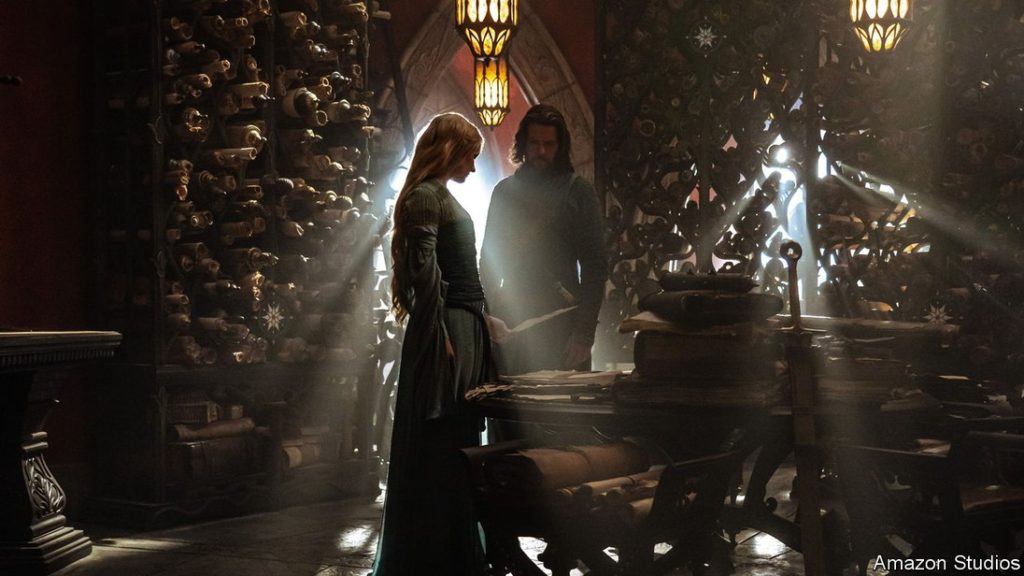
“The lord of the Rings”, a film trilogy based on J.R.R. Tolkien’s novels, set the standard for blockbuster adaptations of beloved books. Released between 2001 and 2003, Peter Jackson’s movies won 17 Academy Awards and grossed almost $3bn from a combined budget of $281m. Now “The Lord of the Rings: The Rings of Power”, a series on Amazon Prime Video, will attempt to match that success.
The show is reportedly the most expensive ever made, with a rumoured price tag of $465m for its first season alone—a number which excludes the $250m paid to the Tolkien estate for the rights. For many industry observers and fans, it demonstrates the current zeitgeist for intellectual property and its importance in the wider streaming wars. More than that, “The Rings of Power” is a statement of Amazon’s grand aspirations.
To date, Amazon Prime Video has struggled to produce a standout series to rival hbo’s “Game of Thrones” or Netflix’s “Stranger Things”. The streamer has had some critical hits, including “The Marvellous Mrs Maisel”, and released some popular genre fare such as “The Boys”, but none has become a broad cultural phenomenon befitting a service with more than 200m users worldwide. Jeff Bezos, Amazon’s founder, spearheaded the acquisition of the rights to “The Lord of the Rings” and “The Hobbit”, no doubt hoping that such stories would propel Amazon to the front of the streaming pack. (Mr Bezos’s son reminded him how treasured the books and films are, as he implored his father not to “eff up” the franchise.)
Underlying Amazon’s effort is its willingness to spend its way to success. Many in Hollywood have long predicted that Amazon would come to dominate the streaming wars thanks to its seemingly bottomless coffers, only to see the company fall short of turning silver into silver-screen winnings. But “The Lord of the Rings: The Rings of Power” does not fall short, at least when it comes to spectacle and scope. Its ambition—and the massive budget spent in service of that ambition—is evident in nearly every scene. From sweeping vistas to detailed interiors, the series recaptures the visual grandiosity of Mr Jackson’s films. It benefits, too, from advances in visual and special effects in the almost 20 years since the last movie instalment.
The show’s story is also elaborate. “The Rings of Power” condenses swathes of Tolkien lore, particularly a 3,400-year period known as the Second Age, into a shorter timeline and follows a large ensemble of elves, dwarves, humans and hobbits as they confront a growing darkness. There are familiar names among the vast troupe, including Galadriel (Morfydd Clark, pictured)—at this point an elf warrior determined to root out evil—and Elrond (Robert Aramayo), a half-elven politician looking to keep the peace. There are new characters, too, such as Bronwyn (Nazanin Boniadi), a human healer engaged in a taboo relationship with Arondir (Ismael Cruz Córdova), an elf warrior. Other storylines focus on legendary figures only briefly mentioned in the original novels and films, such as Isildur (Maxim Baldry), a future human king, and Gil-galad (Benjamin Walker), an elvish king.
Ardent fans will appreciate the references to the original works; more casual observers may struggle to keep the various characters, settings and storylines straight. In the two episodes released for review, the showrunners, J.D. Payne and Patrick McKay, have ensured that the story moves forward confidently and with purpose. Whether that can be maintained across the other six episodes, and then in subsequent seasons, is uncertain. Just as the One Ring corrupted those who wield it, not in spite of but rather because of their grand intentions, the ambition behind the series may lead it astray.
After all, what made “The Lord of the Rings” so effective was the simplicity of the underlying idea. Take away all the different languages, mythologies, races and lands, and you are left with two friends carrying out one clear objective. Tolkien’s ultimate theme was the power of ordinary people to confront evil. For “The Rings of Power” to achieve Amazon’s dream of streaming-war conquest, and live up to the original stories, the series will have to pair its impressive vision with more than just deep pockets. It will need to combine capability with humanity; to make viewers not only marvel at the spectacle but care about the characters caught up in it. As Galadriel, the hero of the show, once proclaimed: “The quest stands upon the edge of a knife. Stray but a little, and it will fail, to the ruin of all. Yet hope remains while the Company is true.”
“The Lord of the Rings: The Rings of Power” is streaming on Amazon Prime Video now
By The Economist




